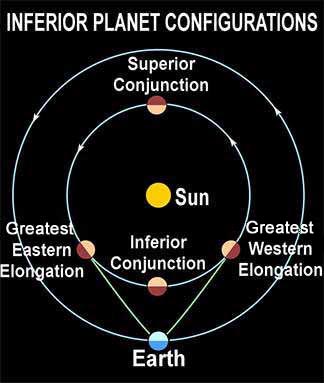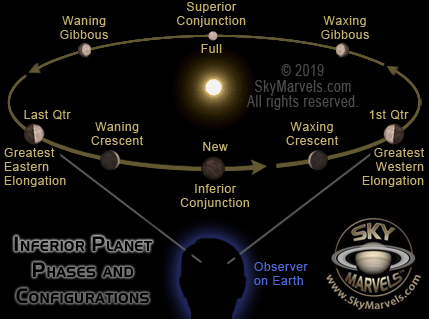
VENUS'S GREATEST ELONGATION OF 2024
Wide FOV Image Credits: NASA/JPL Solar System Simulator developed by: David Seal
L O A D I N G 
This is an interesting year for the second planet from the Sun, as Venus never achieves a Greatest Elongation during the calendar year 2024! This happens about once every eight years, having last occured in 2016. The next year it will occur will be in 2032. The current page therefore shows Venus's two Greatest Elongations of last year (2023) to give you a sense of how the planet appears during its eastern and western maximums.
As an Inferior Planet, one whose orbit is smaller than Earth's, Venus can never move completely around our home planet! This means that Venus—the major planet whose orbit is closest in size to Earth's—repeats a cycle through our skies that makes it "appear" to zig-zag back and forth past the Sun! Current Venus.


The farthest eastern and western angular distances that Venus achieves from the Sun are called its Greatest Elon- gations, and in a single year either zero, one or two Greatest Elongations are possible for Venus, but no more. Click on the labels above to view Venus's Greatest Elongations of 2023. Morning elongations are "west" of the Sun and are therefore seen before sunrise. Evening elongations are "east" of the Sun and are therefore seen before sunset. View them with or without orbits, and zoom in to see how Venus will appear "close-up" at this time. If you are viewing Venus on these dates, also check out the cloud-veiled planet's Current Location in the Constellations and Current Location in Orbit, and compare these to what you see in the above views. And you can find Venus's Greatest Elongations hundreds of years in the past and future with this Venus Elongation Explorer!
Venus is much easier to observe than Mercury. This is because—compared to Mercury's orbit—Venus's orbit is farther from the Sun and closer to Earth's orbit. Therefore, when it is at a Greatest Elongation, Venus can appear over 47° from the Sun! This is 1/8 (one-eighth) of the way around the sky from it! When Venus is east of the Sun it is seen as an "evening star", visible before and after sunset. When it is west of the Sun it is seen as an "morning star", visible before and after sunrise. Moreover, because Venus is so bright, at times it can be seen in what would be considered "broad daylight". It is generally easiest to take advantage of this fact when Venus is near or at its Greatest Elongations, as then it is farthest from the brilliance of the Sun. Even so, not many persons have ever seen Venus during the day; so if you do, you're one of the privileged few!
You can gain further insight about Inner Planet elongations with this Configurations Simulator and this Planetary Phases Simulator. In both simulators' Orbit Sizes boxes, select Earth as "observer" and Venus as "target".
And while you're at it checking out Venus's Elongations, don't forget that you can also find when viewing the "other" Inferior Planet is optimum. Check out Mercury's Greatest Elongations of 2024.
Simulator Image Notes: 1) Fields of View are measured horizontally. 2) Eclipse shadows of planetary moons are not displayed. 3) Light-Travel Time is not included in calculated times. 4) Planet of focus (at center of simulator image) is viewed with its local north "upward", i.e. in the 12:00 midnight direction. 5) Simulator expresses the phase (where applicable) as the absolute value of the phase angle.
Home Intro News Gallery Sky-Gifts Bonuses Tips
Learning Ctr Help Links Credits Legal Contact Us
© 2007-
by Gary M. Winter. All rights reserved.
Interested in political cartoons and humor?
Check out The HIPPLOMATS™.
SkyMarvels, Sky Marvels, SkyMarvels.com, Current Year's Greatest Elongations of Mercury, Mercury's Greatest Elongations for Current Year, celestiaforall, CELESTIA, astronomy, space, simulations, animations, downloadable astronomy posters, stars, planets, Inner Planets, Outer Planets, Inferior Planets, Superior Planets, moons, asteroids, comets, Oort Cloud, galaxy, galaxies, Milky Way, Andromeda, globular clusters, binaries, quasars, black holes, supermassive black holes, telescope, telescopes, planetarium, software, freestuff, satellites, add-ons, addons, scripts, eclipses, Solar Eclipses, Lunar Eclipses, Solar Eclipse Finder, Lunar Eclipse Finder, mutual eclipses, transits, occultations, Solar System, CELES-TOOLS, celeSTARrium, CELX, CELX programming, Freebies, multiple views, atronomical unit, light year, parsec, meteors, meteor showers, Perseids, Geminids, Leonids, barycenter, time, Time Zones, tides, alignments, conjunctions, oppositions, seasons, apogees, perigees, aphelion, perihelion, Earth, Luna, Mercury, Venus, Mars, Jupiter, Galilean Moons, Io, Europa, Ganymede, Callisto, Saturn, Titan, rings, Uranus, Neptune, Triton, E-MSpectrum, electromagnetic spectrum, astronaut, equinoxes, solstices, precession, rotation, spin, inclination, tilt, Ecliptic, orbits, ellipse, parabola, hyperbola
